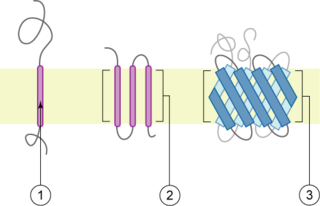
Multidrug resistance-associated protein 2 (MRP2) also called canalicular multispecific organic anion transporter 1 (cMOAT) or ATP-binding cassette sub-family C member 2 (ABCC2) is a protein that in humans is encoded by the ABCC2 gene.

Solute carrier family 22 member 2 is a protein that in humans is encoded by the SLC22A2 gene.

Solute carrier organic anion transporter family member 1B1 is a protein that in humans is encoded by the SLCO1B1 gene. Pharmacogenomic research indicates that genetic variations in this gene are associated with response to simvastatin. Clinical guidelines exist that can guide dosing of simvastatin based on SLCO1B1 gene variant using genotyping or whole exome sequencing.

Equilibrative nucleoside transporter 2 (ENT2) is a protein that in humans is encoded by the SLC29A2 gene.

Solute carrier family 22 member 3 (SLC22A3) also known as the organic cation transporter 3 (OCT3) or extraneuronal monoamine transporter (EMT) is a protein that in humans is encoded by the SLC22A3 gene.

Concentrative nucleoside transporter 2 (CNT2) is a protein that in humans is encoded by the SLC28A2 gene.

Solute carrier family 22 member 11 is a protein that in humans is encoded by the SLC22A11 gene.

Solute carrier family 26 member 6 is a protein that in humans is encoded by the SLC26A6 gene. It is an anion-exchanger expressed in the apical membrane of the kidney proximal tubule, the apical membranes of the duct cells in the pancreas, and the villi of the duodenum.

Solute carrier family 22 member 8, or organic anion transporter 3 (OAT3), is a protein that in humans is encoded by the SLC22A8 gene.

Solute carrier organic anion transporter family member 1B3 (SLCO1B3) also known as organic anion-transporting polypeptide 1B3 (OATP1B3) is a protein that in humans is encoded by the SLCO1B3 gene.

Solute carrier organic anion transporter family member 1A2 is a protein that in humans is encoded by the SLCO1A2 gene.

Solute carrier family 2, facilitated glucose transporter member 12 is a protein that in humans is encoded by the SLC2A12 gene.

Multidrug and toxin extrusion protein 1 (MATE1), also known as solute carrier family 47 member 1, is a protein that in humans is encoded by the SLC47A1 gene. SLC47A1 belongs to the MATE family of transporters that are found in bacteria, archaea and eukaryotes.

Solute carrier organic anion transporter family member 4A1 is a protein that in humans is encoded by the SLCO4A1 gene.

Solute carrier family 22 member 7 is a protein that in humans is encoded by the gene SLC22A7.

Solute carrier family 22 member 9 is a protein that in humans is encoded by the SLC22A9 gene.

Solute carrier organic anion transporter family member 3A1 is a protein that in humans is encoded by the SLCO3A1 gene.

The organic anion transporter 1 (OAT1) also known as solute carrier family 22 member 6 (SLC22A6) is a protein that in humans is encoded by the SLC22A6 gene. It is a member of the organic anion transporter (OAT) family of proteins. OAT1 is a transmembrane protein that is expressed in the brain, the placenta, the eyes, smooth muscles, and the basolateral membrane of proximal tubular cells of the kidneys. It plays a central role in renal organic anion transport. Along with OAT3, OAT1 mediates the uptake of a wide range of relatively small and hydrophilic organic anions from plasma into the cytoplasm of the proximal tubular cells of the kidneys. From there, these substrates are transported into the lumen of the nephrons of the kidneys for excretion. OAT1 homologs have been identified in rats, mice, rabbits, pigs, flounders, and nematodes.

Solute carrier organic anion transporter family member 2A1, also known as the prostaglandin transporter (PGT), is a protein that in humans is encoded by the SLCO2A1 gene.
Members of the Organic Anion Transporter (OAT) Family are membrane transport proteins or 'transporters' that mediate the transport of mainly organic anions across the cell membrane. Therefore, OATPs are present in the lipid bilayer of the cell membrane, acting as the cell's gatekeepers. OATPs belong to the Solute Carrier Family (SLC) and the major facilitator superfamily.















